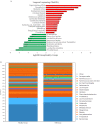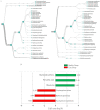Classification of Changes in the Fecal Microbiota Associated with Colonic Adenomatous Polyps Using a Long-Read Sequencing Platform
- PMID: 33233735
- PMCID: PMC7699842
- DOI: 10.3390/genes11111374
Classification of Changes in the Fecal Microbiota Associated with Colonic Adenomatous Polyps Using a Long-Read Sequencing Platform
Abstract
The microbiota is the community of microorganisms that colonizes the oral cavity, respiratory tract, and gut of multicellular organisms. The microbiota exerts manifold physiological and pathological impacts on the organism it inhabits. A growing body of attention is being paid to host-microbiota interplay, which is highly relevant to the development of carcinogenesis. Adenomatous polyps are considered a common hallmark of colorectal cancer, the second leading cause of carcinogenesis-mediated death worldwide. In this study, we examined the relevance between targeted operational taxonomic units and colonic polyps using short- and long-read sequencing platforms. The gut microbiota was assessed in 132 clinical subjects, including 53 healthy participants, 36 patients with occult blood in the gut, and 43 cases with adenomatous polyps. An elevation in the relative abundance of Klebsiella pneumonia, Fusobacterium varium, and Fusobacterium mortiferum was identified in patients with adenomatous polyps compared with the other groups using long-read sequencing workflow. In contrast, the relatively high abundances of Blautia luti, Bacteroides plebeius, and Prevotella copri were characterized in the healthy groups. The diversities in gut microbiota communities were similar in all recruited samples. These results indicated that alterations in gut microbiota were characteristic of participants with adenomatous polyps, which might be relevant to the further development of CRC. These findings provide a potential contribution to the early prediction and interception of CRC occurrence.
Keywords: Oxford nanopore technology; adenomatous polyp; colorectal cancer; gut microbiota.
Conflict of interest statement
The authors declare no conflict of interest.
Figures









Similar articles
-
Gut microbiota signatures in tissues of the colorectal polyp and normal colorectal mucosa, and faeces.Front Cell Infect Microbiol. 2023 Jan 10;12:1054808. doi: 10.3389/fcimb.2022.1054808. eCollection 2022. Front Cell Infect Microbiol. 2023. PMID: 36704106 Free PMC article. Clinical Trial.
-
The microbiota comparative analysis of the characteristics between colorectal adenomatous polyps and normal mucosal intestinal.Eur J Gastroenterol Hepatol. 2024 Nov 1;36(11):1305-1313. doi: 10.1097/MEG.0000000000002836. Epub 2024 Aug 8. Eur J Gastroenterol Hepatol. 2024. PMID: 39166388
-
Gut microbiome associated with APC gene mutation in patients with intestinal adenomatous polyps.Int J Biol Sci. 2020 Jan 1;16(1):135-146. doi: 10.7150/ijbs.37399. eCollection 2020. Int J Biol Sci. 2020. PMID: 31892851 Free PMC article.
-
An Overview of Gut Microbiota and Colon Diseases with a Focus on Adenomatous Colon Polyps.Int J Mol Sci. 2020 Oct 5;21(19):7359. doi: 10.3390/ijms21197359. Int J Mol Sci. 2020. PMID: 33028024 Free PMC article. Review.
-
Systematic review: Gut microbiota in fecal samples and detection of colorectal neoplasms.Gut Microbes. 2018 Jul 4;9(4):293-307. doi: 10.1080/19490976.2018.1445957. Epub 2018 May 15. Gut Microbes. 2018. PMID: 29543545 Free PMC article.
Cited by
-
Interaction of human gut microbiota and local immune system in progression of colorectal adenoma (MIMICA-1): a protocol for a prospective, observational cohort study.Front Oncol. 2025 Jan 6;14:1495635. doi: 10.3389/fonc.2024.1495635. eCollection 2024. Front Oncol. 2025. PMID: 39834942 Free PMC article.
-
Salivary and fecal microbiota: potential new biomarkers for early screening of colorectal polyps.Front Microbiol. 2023 Aug 16;14:1182346. doi: 10.3389/fmicb.2023.1182346. eCollection 2023. Front Microbiol. 2023. PMID: 37655344 Free PMC article.
-
Intestinal microbiota as biomarkers for different colorectal lesions based on colorectal cancer screening participants in community.Front Microbiol. 2025 Feb 7;16:1529858. doi: 10.3389/fmicb.2025.1529858. eCollection 2025. Front Microbiol. 2025. PMID: 39990152 Free PMC article.
-
Fecal Microbiota and Associated Volatile Organic Compounds Distinguishing No-Adenoma from High-Risk Colon Adenoma Adults.Metabolites. 2023 Jul 4;13(7):819. doi: 10.3390/metabo13070819. Metabolites. 2023. PMID: 37512526 Free PMC article.
-
Tissue vs. Fecal-Derived Bacterial Dysbiosis in Precancerous Colorectal Lesions: A Systematic Review.Cancers (Basel). 2023 Mar 4;15(5):1602. doi: 10.3390/cancers15051602. Cancers (Basel). 2023. PMID: 36900392 Free PMC article. Review.
References
-
- Svolos V., Hansen R., Nichols B., Quince C., Ijaz U.Z., Papadopoulou R.T., Edwards C.A., Watson D., Alghamdi A., Brejnrod A., et al. Treatment of Active Crohn’s Disease With an Ordinary Food-based Diet That Replicates Exclusive Enteral Nutrition. Gastroenterology. 2019;156:1354–1367. doi: 10.1053/j.gastro.2018.12.002. - DOI - PubMed
-
- Franzosa E.A., Sirota-Madi A., Avila-Pacheco J., Fornelos N., Haiser H.J., Reinker S., Vatanen T., Hall A.B., Mallick H., McIver L.J., et al. Gut microbiome structure and metabolic activity in inflammatory bowel disease. Nat. Microbiol. 2019;4:293–305. doi: 10.1038/s41564-018-0306-4. - DOI - PMC - PubMed
-
- Sobhani I., Bergsten E., Couffin S., Amiot A., Nebbad B., Barau C., de’Angelis N., Rabot S., Canoui-Poitrine F., Mestivier D., et al. Colorectal cancer-associated microbiota contributes to oncogenic epigenetic signatures. Proc. Natl. Acad. Sci. USA. 2019;116:24285–24295. doi: 10.1073/pnas.1912129116. - DOI - PMC - PubMed
Publication types
MeSH terms
Supplementary concepts
LinkOut - more resources
Full Text Sources
Medical

